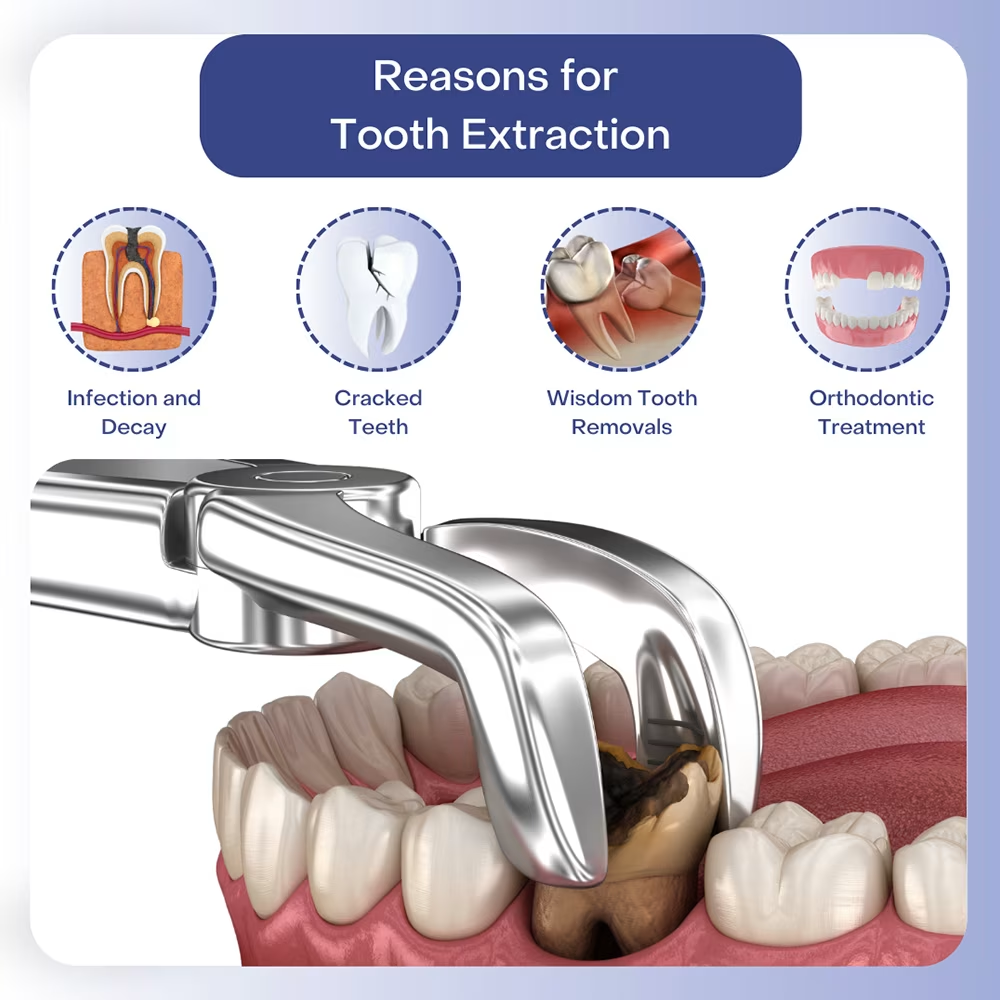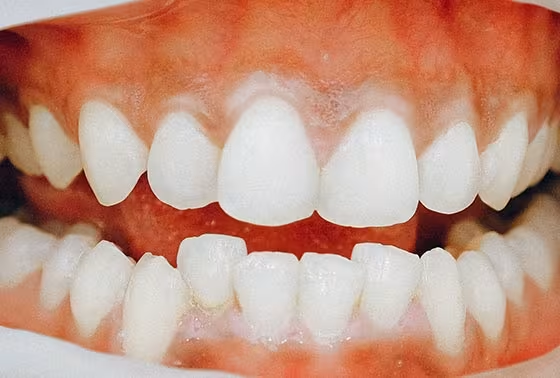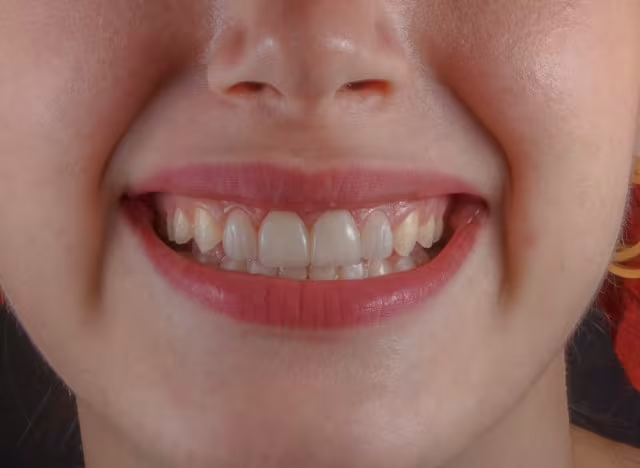Tooth extraction is a common dental procedure that permanently removes a tooth that is beyond recovery.
While dentists always prioritize preserving natural teeth whenever possible, there are situations where extraction becomes necessary for overall oral health.
This guide covers everything you need to know about tooth extractions in Singapore, from when they’re needed to aftercare instructions.
When is a Tooth Extraction Required?

A tooth extraction procedure is needed if a tooth is decayed or broken beyond repair. Depending on the condition of the tooth, extraction procedures include:
Simple Tooth Extraction
This procedure is performed on visible teeth in the mouth under local anesthesia. The tooth is loosened from its socket and then removed with dental forceps.
This is a relatively straightforward procedure for teeth that have fully erupted.
Surgical Tooth Extraction
This is a more complicated procedure for teeth that are badly broken down and cannot be removed without surgery.
Surgical extractions are necessary for teeth that are not easily accessible, such as impacted wisdom teeth, or those that require an incision and possibly removal of some bone.
Read more: Which Dental Clinic in Singapore Should You Consider? (Sort by Reviews)
Common Reasons for Tooth Extraction
There are several situations where a dentist might recommend extracting a tooth:
Severe Tooth Decay (Cavities)
When a cavity becomes too large and damages the inside of the tooth, extraction may be necessary if the tooth cannot be saved with a crown or filling.
Read more: White Spots On Teeth: Causes, Treatments, and Prevention
Gum Disease (Periodontitis)

Advanced gum disease can lead to loss of bone support around the teeth. When this happens, teeth may become loose, and extraction might be required to prevent further complications.
You might like: Receding Gums in Singapore: Causes, Treatments & Prevention
Impacted Teeth
This typically occurs with wisdom teeth that don’t have sufficient space to erupt properly. Impacted teeth can cause pain, swelling, and potential damage to surrounding teeth, making extraction necessary.
Read more: Wisdom Tooth Removal Surgery: Risks, Benefits, Recovery
Overcrowding

If your teeth are too close together, some teeth may need to be removed to create space for orthodontic treatment like braces.
Trauma or Injury
If a tooth is severely damaged due to trauma, such as a sports injury or accident, and cannot be effectively restored, extraction may be necessary.
Infection
A severely infected tooth, especially when the infection has spread to the pulp, may require extraction if root canal therapy isn’t a viable option.
Read more: Root Canal Treatment in Singapore
Pre-orthodontic Treatment
Sometimes, orthodontic treatment requires removing one or more teeth to create space for proper alignment.
Read more: The Complete Guide to Orthodontists in Singapore
Failed Previous Treatments
If treatments like root canals or implants don’t work, extraction might be considered as a last resort.
Signs You Might Need a Tooth Extraction
Look out for these symptoms that might indicate the need for tooth extraction:
- Bad toothache that persists
- Pain that worsens when chewing or biting
- Jaw pain or stiffness
- Swelling around a tooth
- Fever along with dental symptoms (possible infection)
- Loose teeth
- Visible tooth damage or decay
Related article: Orthognathic (Jaw) Surgery in Singapore: Costs, Risks, Recovery
The Tooth Extraction Procedure
Before the Procedure
- Consultation and X-ray Your dentist will take an X-ray of your tooth to evaluate the curvature and angle of the tooth’s root. This helps formulate a precise extraction plan.
- Medical History Review Providing your complete medical history is crucial for your dentist to tailor the procedure safely, particularly if you have health conditions that affect healing or infection risk.
- Pre-operative Care Maintaining good oral hygiene and avoiding hard or sticky foods before the procedure can help minimize complications.
During the Procedure
For Simple Extraction:
- Local Anesthesia Your dentist will administer a local anesthetic to numb the area around the tooth, ensuring you don’t feel pain during the extraction.
- Tooth Loosening Using an instrument called an elevator, the dentist gently loosens the tooth from its socket.
- Removal with Forceps Once sufficiently loosened, the dentist uses forceps to grasp and remove the tooth from the socket.
- Gauze Placement A piece of gauze is placed over the extraction site to help control bleeding and encourage blood clot formation.
For Surgical Extraction:
- Anesthesia Depending on the complexity, your dentist may use local anesthesia, conscious sedation, or general anesthesia.
- Incision The dentist makes a small incision in the gum tissue to access the tooth.
- Bone Removal or Tooth Sectioning If necessary, the dentist may remove a small amount of bone around the tooth or divide the tooth into sections for easier removal.
- Extraction The tooth is carefully removed from its socket.
- Suturing The incision is closed with stitches if needed.
- Gauze Placement Similar to simple extraction, gauze is placed over the site to control bleeding.
Healing Timeline After Tooth Extraction
Simple Tooth Extraction
If your tooth has fully erupted, the wound from your tooth extraction should heal within 7 to 10 days. The gums will usually fully close in about 3-4 weeks after the tooth was extracted, and the bone will regrow in around 3 months.
Surgical Extraction
If your tooth is within the gums (not fully erupted or is badly broken down), recovery will take a little longer. The healing will range from a week to 3 weeks, and it will take about 8 weeks for the hole to close fully.
Expected Healing Timeline
- First 24 Hours: Blood clot forms; minimal activity recommended
- 2-3 Days: Swelling peaks; apply cold packs to reduce it
- 1 Week: Significant improvement in symptoms
- 2 Weeks: Most of the soft tissue healing is complete
- 8 Weeks: The extraction site should be fully closed
- 3 Months: Bone regrowth complete
Post-Extraction Care: Dos and Don’ts
What to Do After a Tooth Extraction
- Apply Pressure on Gauze After your surgical procedure, apply pressure (bite) on the gauze for about 1 to 3 hours to allow clotting.
- Continue Oral Hygiene Continue brushing (lightly) and flossing, but avoid traumatizing the extraction site.
- Take Prescribed Medications Take medications as prescribed, including over-the-counter pain relievers.
- Rest Adequately Limit physical activity during recovery. Vigorous activities increase blood pressure and heart rate, which can induce bleeding.
- Use Ice Packs Apply ice packs to your face for 15-20 minutes at a time with breaks in between to reduce swelling.
- Rinse with Salt Water After 24 hours, gently rinse your mouth with warm salt water (half a teaspoon of salt and 1 cup of water) every few hours to keep the area clean.
- Eat Soft Foods Consume soft foods and liquids for at least a day after extraction. Subsequently, opt for easy-to-chew foods like porridge or soup.
What to Avoid After a Tooth Extraction
- Avoid Sticky and Hard Foods Stay away from nuts, sweets, chocolate, shells, and hard meat that might get lodged in the extraction socket.
- Avoid Hot or Cold Drinks Neighboring teeth may still be sensitive. Don’t drink anything extremely hot or cold over the next few days.
- Avoid Alcohol Alcohol dries and prevents blood clot formation, which may result in a painful dry socket.
- Don’t Smoke Smoking can delay healing and increase the risk of complications.
- Avoid Using Straws Using straws can create suction that might dislodge the blood clot.
- Limit Physical Activities Avoid strenuous physical activities for a few days to prevent excessive bleeding.
- Don’t Touch the Extraction Site Keep fingers and tongue away from the extraction site to avoid introducing bacteria.
- Avoid Vigorous Rinsing or Spitting For the first 24 hours, avoid vigorous rinsing, spitting, or using a straw to prevent dislodging the blood clot.
Common Side Effects and Complications
Normal Side Effects
- Bleeding: The wound may bleed for a few hours after extraction.
- Swelling: Swelling around the extraction site is normal and usually peaks within 24-48 hours.
- Bruising: Some bruising may occur and usually disappears within a week.
- Pain: The area may hurt, which can be managed with prescribed painkillers.
- Nausea: You may feel nauseous or feel like vomiting.
Potential Complications
- Dry Socket Occurs when the blood clot at the extraction site fails to form or becomes dislodged, exposing bone and nerves. This painful condition requires prompt dental attention.
- Infection Signs include severe pain, swelling that worsens, fever, pus or discharge from the extraction site, or numbness in your lip, tongue, or cheek.
- Nerve Injury Particularly during the extraction of lower jaw teeth, there’s a risk of injury to the inferior alveolar nerve, which can result in temporary numbness or tingling.
- Sinus Perforation During the removal of upper teeth, there’s a small risk of creating an opening into the sinus cavity, which may require additional treatment.
Types of Sedation for Tooth Extraction
Local Anesthesia
Numbs only the area around the tooth being extracted, allowing you to stay awake and aware. It’s commonly used for simple extractions and provides quick recovery.
General Anesthesia
Makes you completely unconscious during the extraction. This method is best for complex procedures or patients with severe anxiety, though it requires more recovery time.
IV Sedation
Delivers medication directly into the bloodstream, helping you feel relaxed while still being able to respond to questions. You’ll have little memory of the procedure afterward.
Nitrous Oxide
Also known as “laughing gas,” it helps you feel relaxed while keeping you fully conscious. It works quickly and wears off fast.
Cost of Tooth Extraction in Singapore
The cost of tooth extraction in Singapore varies depending on the complexity of the procedure:
Children:
- $80-180 (without GST)
Adults:
- $95-180 (without GST)
Wisdom Tooth Extraction:
- $250-350 (without GST)
- Specialist fees may differ
Medisave Claims:
- Normal extractions are not Medisave claimable
- Surgical extractions are Medisave claimable
- Singaporeans, permanent residents, or those with immediate family members who are citizens/PRs may use Medisave to cover a significant portion of the cost
Benefits of Tooth Extraction
Despite dentists’ preference to preserve natural teeth, extraction offers several benefits in necessary cases:
- Pain Relief: Removing damaged or infected teeth provides immediate relief from discomfort.
- Infection Control: Prevents the spread of infection to surrounding tissues and bone.
- Gum Health Enhancement: Eliminates sources of harmful bacteria, protecting gums from further damage.
- Prevention of Future Issues: Reduces the risk of developing infections or other problems from damaged teeth.
- Creating Space for Orthodontics: Makes room for teeth to move into their correct positions during orthodontic treatment.
- Aesthetic Improvements: Can facilitate future dental restorations like implants, enhancing smile appearance.
FAQ Section
How painful is tooth extraction?
Tooth extraction is generally not excruciating thanks to modern anesthesia techniques. For simple extractions, dentists use local anesthesia that numbs the area, ensuring you feel only pressure but no pain during the procedure.
For more complex extractions, general anesthesia might be used, putting you to sleep entirely.
After the procedure, you may experience some discomfort and swelling, but this can be managed with prescribed pain medication and typically subsides within a few days.
How long does a tooth extraction take?
The actual extraction usually takes between 20-40 minutes, depending on the tooth’s location and condition.
Simple extractions are generally quicker, often taking less than 30 minutes. Surgical extractions for impacted or broken teeth may take longer, sometimes up to an hour or more.
The overall appointment time may be longer when considering pre-extraction preparations, anesthesia administration, and post-operative instructions.
What can I eat after tooth extraction?
For the first 24 hours after extraction, stick to soft foods and liquids such as yogurt, pudding, soup, mashed potatoes, scrambled eggs, and applesauce.
Avoid hot, spicy, crunchy, sticky, or hard foods that could irritate the extraction site or dislodge the blood clot.
As healing progresses (usually after 3-4 days), you can gradually reintroduce more solid foods, but continue to chew on the opposite side of the extraction site.
Most people can return to their normal diet within a week, though this varies based on individual healing rates.
What is a dry socket and how can I prevent it?
A dry socket occurs when the protective blood clot that forms in the tooth socket becomes dislodged or dissolves prematurely, exposing the underlying bone and nerves.
This condition can cause intense pain that typically begins 3-5 days after extraction. To prevent dry socket, avoid smoking, using straws, spitting forcefully, or vigorous rinsing for at least 72 hours after extraction.
Also, avoid touching the extraction site with your tongue or fingers, follow your dentist’s cleaning instructions carefully, and maintain a soft food diet during the initial healing period.
How long should bleeding last after tooth extraction?
Some bleeding is normal after tooth extraction and typically subsides within a few hours. For the first 1-2 hours, bite firmly on the gauze pad placed by your dentist, replacing it when it becomes soaked with blood.
If bleeding continues beyond 24 hours or becomes heavy (soaking through fresh gauze within 20-30 minutes), contact your dentist as this may indicate a complication.
Light oozing or blood-tinged saliva might be noticeable for up to 72 hours, which is generally normal.
When can I brush my teeth after an extraction?
You can resume brushing your teeth the day after extraction, but avoid the extraction site for the first 24 hours.
When you do start brushing again, be very gentle around the extraction area to prevent disturbing the blood clot. Use a soft-bristled toothbrush and take care not to spit forcefully.
After 24 hours, you can also gently rinse with warm salt water (half a teaspoon of salt in a cup of warm water) several times a day to keep the area clean.
Normal brushing and flossing can usually resume about a week after the procedure, once initial healing has occurred.
Can I smoke after tooth extraction?
It’s strongly recommended to avoid smoking for at least 72 hours after tooth extraction, though ideally, you should refrain for at least a week.
Smoking can significantly delay healing and increases the risk of complications like dry socket. The suction created when drawing on a cigarette can dislodge the blood clot, while the chemicals in tobacco reduce blood flow to the healing area and can introduce bacteria.
If you’re unable to stop completely, at minimum try to reduce smoking and avoid dragging forcefully when you do smoke.
How long should I wait before removing the gauze after tooth extraction?
After your surgical procedure, apply pressure by biting on the gauze for about 1 to 3 hours to allow proper blood clotting. The gauze must remain in place for at least 20–30 minutes initially.
Replace the gauze whenever it becomes soaked with blood. Once the bleeding has substantially decreased or stopped, you can remove the gauze.
However, if bleeding persists beyond 3-4 hours, contact your dentist as this may indicate a complication that requires attention.
When can I resume normal activities after tooth extraction?
It’s best to rest for the first 24 hours after tooth extraction. Limit physical activity during this initial recovery period as strenuous activities can increase blood pressure and heart rate, potentially inducing bleeding.
Most people can return to work or school within a day or two after a simple extraction. However, if your job requires heavy lifting or significant physical exertion, you might need to take additional days off.
For surgical extractions, a longer recovery period of 3-4 days might be necessary before resuming normal activities. Always follow your dentist’s specific recommendations based on your situation.
Can tooth extraction affect my face shape?
Tooth extraction can potentially alter facial structure over time, particularly if multiple teeth are removed without replacement. When teeth are extracted, the jawbone that previously supported those teeth can gradually deteriorate through a process called resorption.
This bone loss can lead to subtle changes in facial appearance, including a more sunken look in the cheeks or lips.
The impact on facial appearance varies based on factors like age, the number and location of extracted teeth, and whether they’re replaced with implants or dentures.
To minimize aesthetic changes, discuss tooth replacement options with your dentist when extraction is necessary.
Is tooth extraction covered by Medisave in Singapore?
In Singapore, Medisave coverage for tooth extraction depends on the type of procedure. Simple extractions are generally not Medisave claimable. However, surgical extractions (including impacted wisdom teeth removal) are typically Medisave claimable.
If you’re a Singaporean citizen, permanent resident, or have an immediate family member who is, you may use Medisave to cover a significant portion of the surgical extraction cost.
The exact coverage amount depends on the complexity of the procedure and your available Medisave balance.
It’s advisable to check with your dental provider regarding the specific Medisave-eligible procedures and claiming process before undergoing treatment.
By understanding the tooth extraction process, proper aftercare, and potential complications, you can ensure a smoother recovery experience.
Always follow your dentist’s specific instructions and don’t hesitate to contact them if you have any concerns during your healing period.

